Butterflies and Moths
Media

Species Types
Scientific Name
Catocala illecta
Description
The magdalen underwing is one of dozens in its genus found in Missouri. You can tell it from the others by the specific pattern on the brightly colored hindwings, which are usually covered by the dull brown forewings.
Media

Species Types
Scientific Name
Darapsa myron
Description
The Virginia creeper sphinx moth is common in woods and brushy areas and comes to lights at night. The larvae eat Virginia creeper and grape leaves.
Media
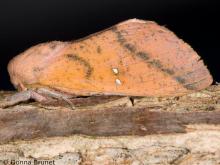
Species Types
Scientific Name
Syssphinx bicolor (syn. Sphingicampa bicolor)
Description
Honey locust moths are gray in spring and increasingly yellow, tan, or rusty later as the season progresses. The hindwings are typically rose-colored.
Media
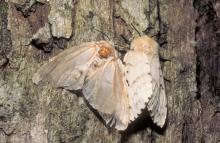
Species Types
Scientific Name
Lymantria dispar
Description
The spongy moth, introduced to our continent from Europe, has caused millions of dollars in damages to forests. Help protect our forests by learning how to recognize the spongy moth, and its larvae and egg masses, and report any occurrences you find.
Media
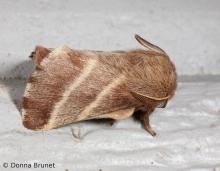
Species Types
Scientific Name
About 35 species in North America north of Mexico
Description
Tent caterpillar moths and lappet moths are medium-sized, with thick, long scales that make them look furry. The abdomen usually extends past the wings when they are folded back over the body.
Media

Species Types
Scientific Name
About 1,400 species in North America north of Mexico
Description
At rest, tortricid moths often have a distinctive shape, resembling an arrowhead or a bell, with the forewing tips either squared-off or flared outward.
Media
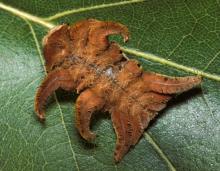
Species Types
Scientific Name
More than 20 species in Missouri
Description
Adult slug caterpillar moths are heavy-bodied and furry. The weird-looking caterpillars have suckers instead of prolegs, so they glide around like slugs. Don’t touch — many have stinging spines or hairs.
Media

Species Types
Scientific Name
About 25 species in North America north of Mexico
Description
Leaf skeletonizer moths are also called smoky moths because they have translucent smoky-brown, brownish gray, or black wings. Many species also have patches or orange or rusty color. Larvae eat all but the veins of leaves, leaving a skeleton of veins behind.
Media

Species Types
Scientific Name
Hyphantria cunea
Description
Fall webworm moths may be either completely white or have varying amounts of dark spots. The larvae are hairy caterpillars that live communally in late summer and fall in tentlike webs on the branch tips of trees.
Media
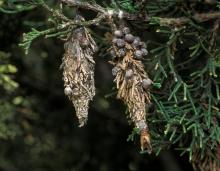
Species Types
Scientific Name
Thyridopteryx ephemeraeformis
Description
The larvae of bagworm moths live in protective cases they make out of their own silk plus plant materials or other debris. These spindle-shaped cases dangle from the food plants they’re eating.
See Also


Media

Species Types
Scientific Name
About 1,500 species in North America north of Mexico
Description
Adult caddisflies are mothlike. Their larvae are aquatic and build portable, protective cases out of local materials, including grains of sand, bits of leaves and twigs, and other debris.
Media

Species Types
Scientific Name
Corydalus cornutus
Description
Adult eastern dobsonflies are huge and mothlike, with large wings and a weak, fluttery flight. The fiercely predaceous aquatic larvae, called hellgrammites, are well-known to anglers, who often use them as bait.
About Butterflies and Moths in Missouri
Butterflies, skippers, and moths belong to an insect order called the Lepidoptera — the "scale-winged" insects. These living jewels have tiny, overlapping scales that cover their wings like shingles. The scales, whether muted or colorful, seem dusty if they rub off on your fingers. Many butterflies and moths are associated with particular types of food plants, which their caterpillars must eat in order to survive.





















